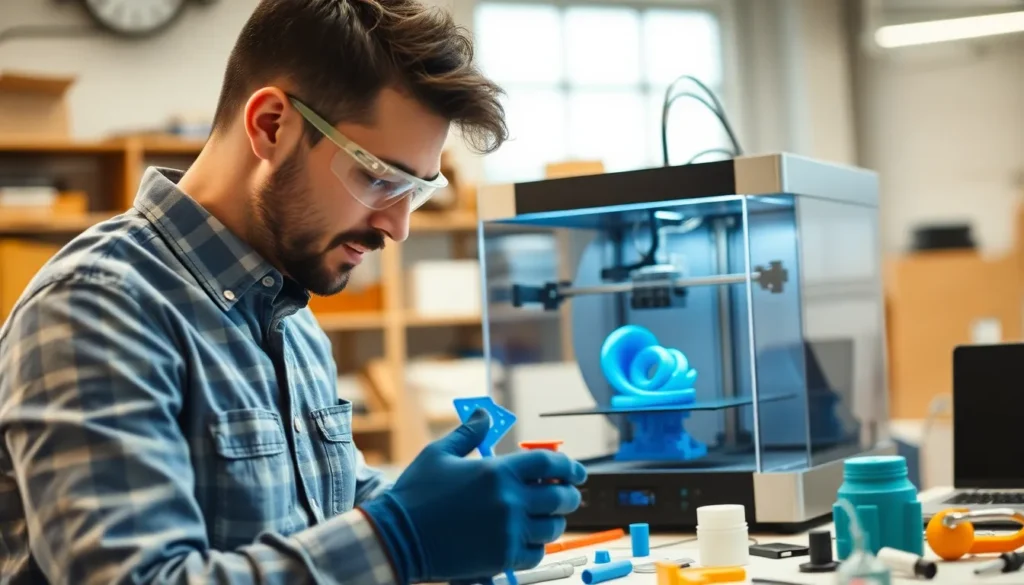Table of Contents
ToggleIn a world where instant gratification reigns supreme, additive manufacturing is the superhero we never knew we needed. Gone are the days of waiting weeks for a part to be shipped or crafted. Instead, this innovative technology layers materials like a pro chef stacks pancakes, creating everything from intricate designs to functional prototypes faster than you can say “3D printer.”
Imagine a future where your wildest ideas come to life with just a few clicks, and the only limit is your imagination. Additive manufacturing isn’t just a trend; it’s a revolution that’s reshaping industries and making dreams a reality. So buckle up as we dive into the fascinating world of 3D printing, where creativity meets technology, and the only thing more exciting than the process is the endless possibilities it offers.
Overview of Additive Manufacturing
Additive manufacturing, commonly known as 3D printing, revolutionizes the way products are created. This technology streamlines the construction process, enabling fast and efficient production of components and prototypes.
Definition and Key Concepts
Additive manufacturing refers to processes used to create three-dimensional objects from digital files. Layer-by-layer material addition characterizes this method, contrasting with traditional subtractive manufacturing. Various materials like plastics, metals, and ceramics are utilized in additive manufacturing. This approach allows for greater design complexity and customization in products such as medical implants and aerospace components.
History and Evolution
The origins of additive manufacturing trace back to the early 1980s. Chuck Hull invented stereolithography in 1983, beginning the movement toward 3D printing technologies. Over the decades, other methods emerged, including selective laser sintering and fused deposition modeling. As technology advanced, costs decreased, making 3D printing more accessible for industries and consumers alike. By the 2000s, additive manufacturing gained traction in automotive, healthcare, and consumer goods sectors. Now, this evolving field continues to spur innovations, expanding applications across various disciplines.
Types of Additive Manufacturing Technologies
Additive manufacturing encompasses several technologies, each with unique processes and applications. Here’s a closer look at the most widely used types.
Fused Deposition Modeling (FDM)
Fused Deposition Modeling (FDM) stands out as one of the most common 3D printing techniques. This process involves melting thermoplastic filament and depositing it layer by layer to build objects. Print heads move along designated paths, gradually creating complex shapes. FDM technology supports a wide range of materials, making it ideal for various applications, from prototyping to functional end-use parts. It excels in producing durable components while maintaining relatively low costs. Popular in educational and hobbyist environments, FDM printers offer accessibility and ease of use.
Stereolithography (SLA)
Stereolithography (SLA) plays a crucial role in high-precision additive manufacturing. This technique utilizes ultraviolet light to cure liquid resin layer by layer, forming solid objects with fine details. The intricate patterns achievable through SLA make it a favorite for industries requiring detailed prototypes, such as jewelry and dental applications. SLA creates smooth surface finishes, providing excellent aesthetic quality. While it might involve higher initial costs for materials, the superior resolution and accuracy offered by SLA justify this investment. Users often appreciate the speed of the printing process, significantly reducing lead times.
Selective Laser Sintering (SLS)
Selective Laser Sintering (SLS) employs a high-powered laser to fuse powdered materials into solid structures. This method allows for complex geometries that other techniques may struggle to replicate. Primarily used with plastics and metals, SLS offers excellent mechanical properties for functional prototypes and end-use parts. The ability to create lightweight yet strong components appeals to industries like aerospace and automotive. SLS does not require support structures, allowing for greater design freedom and material efficiency. Many professionals appreciate the versatility that SLS brings to additive manufacturing projects.
Applications of Additive Manufacturing
Additive manufacturing finds extensive applications across numerous industries. Its innovation reshapes how products are designed and produced.
Aerospace Industry
Aerospace companies leverage additive manufacturing for creating lightweight components. Sets of intricate parts can be fabricated, resulting in reduced weight and improved fuel efficiency. Components like brackets and housings benefit from the design freedom offered by this technology. Employing materials such as titanium allows for high strength-to-weight ratios. Forming complex geometries without the need for assembly reduces manufacturing costs and enhances performance.
Medical Field
In the medical field, additive manufacturing enables the production of patient-specific implants and prosthetics. Custom orthopedic implants can be tailored to fit individual anatomies, improving surgical outcomes. Bioprinting advances regenerative medicine by creating tissue and organ models for research and drug testing. Surgical guides made from 3D printed materials ensure precision during procedures. This technology also streamlines the production of dental devices, allowing for swift and accurate fabrication.
Consumer Products
Consumer products increasingly incorporate additive manufacturing for rapid prototyping and customization. Designers create prototypes quickly, facilitating iterative testing and feedback. Personalized items such as footwear and accessories benefit from unique designs meeting specific customer requirements. Manufacturing small batches of products becomes economically viable with reduced lead times. Brands gain a competitive edge by offering customized solutions while minimizing waste through efficient production processes.
Benefits and Challenges
Additive manufacturing offers significant advantages but also presents challenges.
Advantages of Additive Manufacturing
Speed stands out as a primary benefit. Rapid prototyping enables faster design iterations, minimizing the time from concept to final product. Customization follows closely, allowing tailored solutions for specific applications, such as personalized medical implants. Material efficiency plays a critical role; additive manufacturing produces items layer by layer, leading to less waste compared to traditional methods. Cost savings arise notably in small production runs, where the elimination of expensive molds reduces upfront investments. Lastly, complexity of design is no longer a limitation. Manufacturers can create intricate geometries that enhance functionality and aesthetics.
Limitations and Barriers
Despite its many advantages, limitations exist. Material constraints restrict the types of substances usable in many applications. Certain processes may not meet the required mechanical properties for high-stress environments, particularly in aerospace and automotive sectors. Post-processing needs can complicate workflows, adding time and cost to the production cycle. Equipment costs pose a barrier; high-quality printers and maintenance require significant investment upfront. Regulatory challenges linger, as industries like healthcare face stringent certification processes for new products. Concerns about intellectual property also arise, especially with the ease of copying designs in a digital format.
Future Trends in Additive Manufacturing
The future of additive manufacturing promises exciting advancements and innovative changes across various sectors. Emerging technologies are set to revolutionize the field, while sustainability considerations will play a crucial role in shaping practices.
Emerging Technologies
Continued developments in additive manufacturing technologies transform production methods. Innovations like continuous liquid interface production (CLIP) enhance speed and accuracy, allowing for the creation of parts with improved finish and detail. Additionally, advancements in materials science lead to stronger and more versatile printing materials, such as metal alloys and composites. These new materials expand the capabilities of 3D printing, making it suitable for more applications. Machine learning and AI integration optimize design processes, identifying efficiencies and performance improvements in real time. The combination of these technologies fosters enhanced design freedom and enables the production of more complex geometries.
Sustainability Considerations
Sustainability emerges as a pivotal focus within additive manufacturing trends. This method promotes material efficiency, significantly reducing waste during production. Recycling of materials becomes more prevalent, with companies increasingly utilizing recycled plastics and metals. Moreover, localized production diminishes the carbon footprint associated with transportation. The capacity to create lightweight components leads to reduced energy consumption in product use, particularly in industries like aerospace and automotive. Sustainable practices also include energy-efficient printing methods that minimize resource consumption. Emphasizing these considerations aligns additive manufacturing with global sustainability goals, ensuring its relevance in an environmentally conscious future.
Conclusion
Additive manufacturing is undeniably revolutionizing the way industries approach design and production. Its ability to create complex and customized components quickly is reshaping traditional manufacturing paradigms. As technology continues to evolve and become more accessible, businesses across various sectors are poised to harness its full potential.
The focus on sustainability and innovative materials further enhances its appeal, aligning with modern environmental goals. With ongoing advancements in techniques and applications, the future of additive manufacturing looks promising. This transformative technology is not just a trend; it’s a pivotal force driving creativity and efficiency in manufacturing processes.




